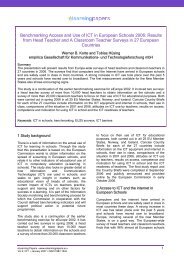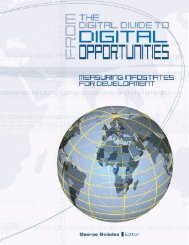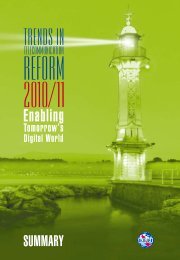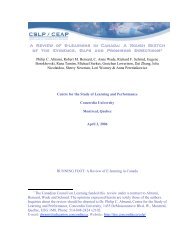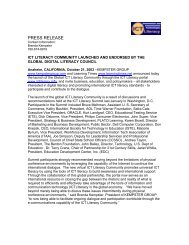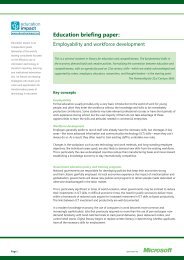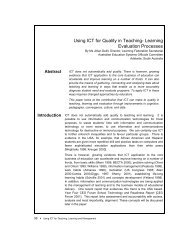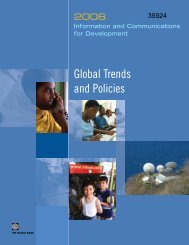The Digital Opportunity Index (DOI) - ITU
The Digital Opportunity Index (DOI) - ITU
The Digital Opportunity Index (DOI) - ITU
You also want an ePaper? Increase the reach of your titles
YUMPU automatically turns print PDFs into web optimized ePapers that Google loves.
Annex: Methodological Note on <strong>Digital</strong> <strong>Opportunity</strong> <strong>Index</strong><br />
<strong>The</strong> definitions of the core indicators used to compile the <strong>Digital</strong> <strong>Opportunity</strong> <strong>Index</strong> (<strong>DOI</strong>) are available from the Partnership<br />
for Measuring ICT for Development. <strong>The</strong> latest available data (year-end 2005) was used, except where noted otherwise.<br />
Where 2005 data were not available, later data was used for tariffs while for other indicators, earlier data was used or an<br />
estimate was made. This section identifies the methodology used to compile the indicators for this version of the <strong>DOI</strong>,<br />
including the time period of the data, and where necessary, the estimation technique.<br />
Indicator<br />
Percentage of population<br />
covered by mobile<br />
cellular telephony<br />
Internet access tariffs (20<br />
hours per month) as a<br />
percentage of per capita<br />
income<br />
Mobile cellular tariffs as a<br />
percentage of per capita<br />
income<br />
Proportion of households<br />
with a fixed line<br />
telephone<br />
Proportion of households<br />
with a computer<br />
Proportion of households<br />
with Internet access at<br />
home<br />
Mobile cellular<br />
subscribers per 100<br />
inhabitants<br />
Core<br />
code<br />
A-7<br />
A-8<br />
A-9<br />
HH-<br />
3<br />
HH-<br />
5<br />
HH-<br />
7<br />
A-2<br />
Mobile Internet<br />
subscribers A-<br />
4†<br />
Proportion of individuals<br />
that used the Internet<br />
Proportion of fixed<br />
broadband subscribers to<br />
total Internet subscribers<br />
Proportion of mobile<br />
broadband subscribers to<br />
total mobile subscribers<br />
HH-<br />
8<br />
A-<br />
5†<br />
A-<br />
5†<br />
Note<br />
<strong>The</strong> base year is 2005. This data is generally available from many mobile network operators.<br />
If national data are not available from an official source, the figure for the largest operator is<br />
used. In rare instances, this may understate actual coverage since different operators could<br />
cover different sections of the country. In the absence of data for a few countries, the percentage<br />
of the urban population is used on the assumption that it is less costly to install infrastructure<br />
in those areas and they have a greater number of potential clients that can afford<br />
service.<br />
<strong>The</strong> base year is 2006 since this is the latest year for which a complete set of comparable data<br />
is available. Data are based on the cheapest available package for 20 hours of use per month<br />
and do not include telephone line rental. <strong>The</strong> basket is divided by 2004 Gross National Income<br />
per capita (from the World Bank).<br />
<strong>The</strong> base year is 2005, since this is the latest year for which a complete set of comparable data<br />
is available. A monthly charge is compiled based on a basket of peak and off-peak and on-net,<br />
off-net and fixed calls. <strong>The</strong> basket is divided by 2004 Gross National Income per capita (from<br />
the World Bank).<br />
This indicator, which is based on 2005 data, should ideally be compiled from a household<br />
survey. If not available, administrative records can be used for the number of residential telephone<br />
lines divided by the number of households.<br />
This indicator, which is based on 2005 data, should be compiled from a household survey. If<br />
not available, data on the number of computers in the country could be used, adjusted for the<br />
estimated amount in homes. If that data is not available, then the data are estimated based on<br />
the per capita income of regional peers.<br />
This indicator, which is based on 2005 data, should be compiled from a household survey. I not<br />
available, data on the number of Internet subscriptions, adjusted for the estimated amount in<br />
homes, can be used. If that data is not available, then the data are estimated based on the per<br />
capita income of regional peers.<br />
<strong>The</strong> base year is 2005. Data are universally available for this indicator.<br />
<strong>The</strong> base year is 2005. Since mobile Internet access is relatively recent, many countries either<br />
do not report data on the number of subscribers or definitions vary.. <strong>The</strong>re are a variety of indicators<br />
used to reflect mobile Internet use. Some operators report the number of high-speed<br />
subscriptions and others report the number of subscriptions to their mobile portal services.<br />
Some users utilize mobile cellular networks to access the Internet using laptop computers.<br />
<strong>The</strong>re is little consensus as to whether these types of users should be considered fixed Internet<br />
subscribers or mobile Internet subscribers. Finally, the concept of Internet access is seriously<br />
challenged when including mobile, since the users’ experience is entirely different and<br />
many so-called mobile Internet users are not actually surfing websites per se but downloading<br />
logos and ring tones or sending picture messages. In general, either the number of Wireless<br />
Access Protocol (WAP), General Packet Radio Service (GPRS) or mobile portal subscribers<br />
is used. In the absence of data, estimates are based on the number of post-paid subscribers,<br />
the availability of mobile data networks (e.g., GPRS, EDGE, CDMA2000 or WCDMA) and regional<br />
trends.<br />
<strong>The</strong> base year is 2005. A growing number of countries have carried out surveys. In the absence<br />
of survey data, national estimates are used. If these are lacking, then estimates are derived<br />
from the number of subscribers.<br />
<strong>The</strong> base year is 2005. <strong>The</strong>re is a growing consensus that a service should be considered<br />
broadband only if it offers speeds of at least 256 kbit/s in at least one direction. Note that this<br />
indicator refers to ‘fixed‘ type of broadband access such as DSL, cable modem, Ethernet LAN,<br />
fibre optic and Fixed Wireless Access. This data set is generally complete for most countries<br />
that have broadband service.<br />
<strong>The</strong> base year is 2005. Mobile broadband subscribers refer to users of mobile networks providing<br />
speeds of at least 256 kbit/s in at least one direction. This data set is generally complete for<br />
countries that have mobile broadband service.<br />
Source: <strong>ITU</strong>/UNCTAD/KADO <strong>Digital</strong> <strong>Opportunity</strong> Platform.<br />
† = Derivation of core indicator<br />
World Information Society Report 2007<br />
55



